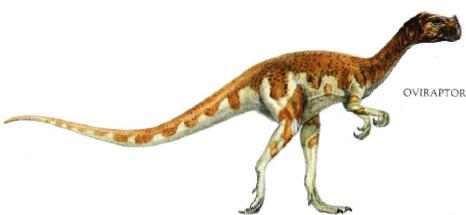Oviraptor philoceratops was a little Mongolian theropod dinosaur named by Henry Fairfield Osborn in 1924. Its name is Latin for "egg thief", as it was fossilized on a pile of presumed Protoceratops eggs. However, it is now supposed that the eggs belonged to this genus itself, and that it was actually brooding its eggs, based on discoveries of a related animal called Citipati, named by Clark, Makovicky, and Barsbold in 2000. Oviraptor forms the basis of a collection called Oviraptoridae, named by Barsbold Rinchen in 1976. Barsbold then used the name to coin a group called Oviraptorosauria.

Oviraptor may have eaten eggs; however Barsbold R. in 1977 argued that the strength of its beak indicates that it could break the shells of mollusks such as clams, which are found in the same formation as Oviraptor. The idea of a crushing jaw was first proposed by H. F. Osborn, who noticed both a toothless beak in the original skull and the extension of several bones below the jaw from the palate would have made an "egg-piercing" tool. These bones, ectopterygoids, are not actually part of the egg-piercing structure, and what Osborn found was incorrect.
In the 1950s and 60s, however, and described in the 70s and 80s, several skulls of oviraptorids have been found which show that they really are egg-piercing bones, as part of the main upper jaw bone or maxilla, which converge in the center to form a pair of prongs. The rest of the bony palate, unlike all other dinosaurs, is extended below the jaw line and would have pressed into the space between the toothless lower jaws. A rhamphotheca, or the keratin forming the beaks of birds, enclosed the edges of upper and lower beaks and probably the palate, as proposed by Barsbold and Osborn.
James Guerney in his book Dinotopia conceived of an animal based on Oviraptor which, because some felt it was no longer considered a predator of eggs, determined to rename the animal by creating a being he called "Ovinutrix". However, this renaming would be unnecessary, for even if the animal brooded its own eggs, this doesn't mean it didn't eat the eggs of other animals.
Oviraptor lived in the late Cretaceous time, in a Stage known as the Santonian, and may have lived in the younger Stage called the Companion between 80 to 70 million years ago; it comes almost wholly from the Djadokhta Formation of Mongolia, as well as the northeast region the Neimongol Autonomous Region of China, in a area called Bayan Mandahu. Relatives of Oviraptor comprise Ingenia and Chirostenotes.
| Name: | Oviraptor |
| Size: | 2 m. (6 ft.) |
| Main Facts: | Renamed as ""Ovinutrix" and it is called as "Egg-thief". |